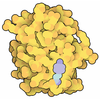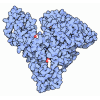| 登録情報 | データベース: PDB / ID: 3k22
|
|---|
| タイトル | Glucocorticoid Receptor with Bound alaninamide 10 with TIF2 peptide |
|---|
 要素 要素 | - Glucocorticoid receptor
- Transcriptional Intermediary Factor 2
|
|---|
 キーワード キーワード | TRANSCRIPTION / Glucocorticoid Receptor / Steroid Hormone Receptor / Nuclear Receptor / GR / glucocorticoids / alpha helical sandwich / meta-channel / Alternative initiation / Chromatin regulator / Disease mutation / DNA-binding / Isopeptide bond / Lipid-binding / Metal-binding / Nucleus / Phosphoprotein / Pseudohermaphroditism / Receptor / Steroid-binding / Transcription regulation / Zinc-finger |
|---|
| 機能・相同性 |  機能・相同性情報 機能・相同性情報
Regulation of NPAS4 gene transcription / regulation of glucocorticoid biosynthetic process / nuclear glucocorticoid receptor activity / steroid hormone binding / glucocorticoid metabolic process / response to cortisol / PTK6 Expression / neuroinflammatory response / mammary gland duct morphogenesis / microglia differentiation ...Regulation of NPAS4 gene transcription / regulation of glucocorticoid biosynthetic process / nuclear glucocorticoid receptor activity / steroid hormone binding / glucocorticoid metabolic process / response to cortisol / PTK6 Expression / neuroinflammatory response / mammary gland duct morphogenesis / microglia differentiation / maternal behavior / astrocyte differentiation / adrenal gland development / RNA polymerase II intronic transcription regulatory region sequence-specific DNA binding / regulation of gluconeogenesis / cellular response to glucocorticoid stimulus / cellular response to steroid hormone stimulus / locomotor rhythm / motor behavior / aryl hydrocarbon receptor binding / cellular response to Thyroglobulin triiodothyronine / regulation of lipid metabolic process / regulation of glucose metabolic process / Synthesis of bile acids and bile salts / estrogen response element binding / Synthesis of bile acids and bile salts via 27-hydroxycholesterol / cellular response to dexamethasone stimulus / Endogenous sterols / Synthesis of bile acids and bile salts via 7alpha-hydroxycholesterol / nuclear receptor-mediated steroid hormone signaling pathway / FOXO-mediated transcription of oxidative stress, metabolic and neuronal genes / cellular response to transforming growth factor beta stimulus / core promoter sequence-specific DNA binding / cellular response to hormone stimulus / Recycling of bile acids and salts / transcription regulator inhibitor activity / steroid binding / : / positive regulation of adipose tissue development / Regulation of lipid metabolism by PPARalpha / peroxisome proliferator activated receptor signaling pathway / regulation of cellular response to insulin stimulus / BMAL1:CLOCK,NPAS2 activates circadian expression / SUMOylation of transcription cofactors / Activation of gene expression by SREBF (SREBP) / response to progesterone / TBP-class protein binding / HSP90 chaperone cycle for steroid hormone receptors (SHR) in the presence of ligand / nuclear receptor binding / negative regulation of smoothened signaling pathway / RNA polymerase II transcription regulatory region sequence-specific DNA binding / chromosome segregation / synaptic transmission, glutamatergic / SUMOylation of intracellular receptors / promoter-specific chromatin binding / Hsp90 protein binding / circadian regulation of gene expression / mRNA transcription by RNA polymerase II / Heme signaling / Transcriptional activation of mitochondrial biogenesis / PPARA activates gene expression / Activated PKN1 stimulates transcription of AR (androgen receptor) regulated genes KLK2 and KLK3 / Cytoprotection by HMOX1 / Nuclear Receptor transcription pathway / Transcriptional regulation of white adipocyte differentiation / response to wounding / positive regulation of miRNA transcription / DNA-binding transcription repressor activity, RNA polymerase II-specific / RNA polymerase II transcription regulator complex / spindle / nuclear receptor activity / Regulation of RUNX2 expression and activity / sequence-specific double-stranded DNA binding / : / positive regulation of neuron apoptotic process / HATs acetylate histones / chromatin organization / MLL4 and MLL3 complexes regulate expression of PPARG target genes in adipogenesis and hepatic steatosis / DNA-binding transcription activator activity, RNA polymerase II-specific / transcription regulator complex / gene expression / Estrogen-dependent gene expression / Potential therapeutics for SARS / DNA-binding transcription factor activity, RNA polymerase II-specific / transcription coactivator activity / protein dimerization activity / nuclear speck / nuclear body / RNA polymerase II cis-regulatory region sequence-specific DNA binding / mitochondrial matrix / DNA-binding transcription factor activity / protein domain specific binding / cell division / negative regulation of DNA-templated transcription / apoptotic process / synapse / centrosome / chromatin binding / regulation of DNA-templated transcription / regulation of transcription by RNA polymerase II類似検索 - 分子機能 Glucocorticoid receptor / Glucocorticoid receptor / Nuclear receptor coactivator 2 / Nuclear receptor coactivator 2/3, DUF4927 / Domain of unknown function (DUF4927) / Nuclear receptor coactivator, DUF1518 / Nuclear receptor coactivator, Ncoa-type, interlocking / Nuclear receptor coactivator, Ncoa-type, interlocking domain superfamily / Nuclear receptor coactivator, DUF1518 / Nuclear receptor coactivator ...Glucocorticoid receptor / Glucocorticoid receptor / Nuclear receptor coactivator 2 / Nuclear receptor coactivator 2/3, DUF4927 / Domain of unknown function (DUF4927) / Nuclear receptor coactivator, DUF1518 / Nuclear receptor coactivator, Ncoa-type, interlocking / Nuclear receptor coactivator, Ncoa-type, interlocking domain superfamily / Nuclear receptor coactivator, DUF1518 / Nuclear receptor coactivator / DUF1518 / Nuclear receptor coactivator, receptor-binding domain / Nuclear receptor coactivator / : / Steroid receptor coactivator / Unstructured region on nuclear receptor coactivator protein / Nuclear receptor coactivators bHLH domain / : / PAS domain / Nuclear receptor coactivator, interlocking / helix loop helix domain / Myc-type, basic helix-loop-helix (bHLH) domain / Myc-type, basic helix-loop-helix (bHLH) domain profile. / Helix-loop-helix DNA-binding domain superfamily / PAS fold / PAS fold / PAS domain / PAS repeat profile. / PAS domain / Retinoid X Receptor / Retinoid X Receptor / PAS domain superfamily / Nuclear hormone receptor / Nuclear hormones receptors DNA-binding region signature. / Zinc finger, nuclear hormone receptor-type / Double treble clef zinc finger, C4 type / Nuclear hormone receptors DNA-binding domain profile. / c4 zinc finger in nuclear hormone receptors / Nuclear hormone receptor, ligand-binding domain / Nuclear hormone receptor-like domain superfamily / Ligand-binding domain of nuclear hormone receptor / Nuclear receptor (NR) ligand-binding (LBD) domain profile. / Ligand binding domain of hormone receptors / Zinc finger, NHR/GATA-type / Orthogonal Bundle / Mainly Alpha類似検索 - ドメイン・相同性 hexyl beta-D-glucopyranoside / Chem-JZS / Glucocorticoid receptor / Nuclear receptor coactivator 2類似検索 - 構成要素 |
|---|
| 生物種 |  Homo sapiens (ヒト) Homo sapiens (ヒト) |
|---|
| 手法 |  X線回折 / X線回折 /  シンクロトロン / シンクロトロン /  分子置換 / 解像度: 2.1 Å 分子置換 / 解像度: 2.1 Å |
|---|
 データ登録者 データ登録者 | Biggadike, K.B. / McLay, I.M. / Madauss, K.P. / Williams, S.P. / Bledsoe, R.K. |
|---|
 引用 引用 |  ジャーナル: Proc.Natl.Acad.Sci.USA / 年: 2009 ジャーナル: Proc.Natl.Acad.Sci.USA / 年: 2009
タイトル: Design and x-ray crystal structures of high-potency nonsteroidal glucocorticoid agonists exploiting a novel binding site on the receptor.
著者: Biggadike, K. / Bledsoe, R.K. / Coe, D.M. / Cooper, T.W. / House, D. / Iannone, M.A. / Macdonald, S.J. / Madauss, K.P. / McLay, I.M. / Shipley, T.J. / Taylor, S.J. / Tran, T.B. / Uings, I.J. ...著者: Biggadike, K. / Bledsoe, R.K. / Coe, D.M. / Cooper, T.W. / House, D. / Iannone, M.A. / Macdonald, S.J. / Madauss, K.P. / McLay, I.M. / Shipley, T.J. / Taylor, S.J. / Tran, T.B. / Uings, I.J. / Weller, V. / Williams, S.P. |
|---|
| 履歴 | | 登録 | 2009年9月29日 | 登録サイト: RCSB / 処理サイト: RCSB |
|---|
| 改定 1.0 | 2010年8月11日 | Provider: repository / タイプ: Initial release |
|---|
| 改定 1.1 | 2011年7月13日 | Group: Version format compliance |
|---|
| 改定 1.2 | 2013年9月25日 | Group: Derived calculations |
|---|
| 改定 1.3 | 2017年11月1日 | Group: Refinement description / カテゴリ: software |
|---|
| 改定 1.4 | 2020年7月29日 | Group: Advisory / Data collection ...Advisory / Data collection / Database references / Derived calculations
カテゴリ: chem_comp / database_PDB_caveat ...chem_comp / database_PDB_caveat / struct_ref_seq_dif / struct_site / struct_site_gen
Item: _chem_comp.mon_nstd_flag / _chem_comp.type / _struct_ref_seq_dif.details
解説: Carbohydrate remediation / Provider: repository / タイプ: Remediation |
|---|
| 改定 1.5 | 2021年10月13日 | Group: Database references / Structure summary / カテゴリ: chem_comp / database_2 / struct_ref_seq_dif
Item: _chem_comp.pdbx_synonyms / _database_2.pdbx_DOI ..._chem_comp.pdbx_synonyms / _database_2.pdbx_DOI / _database_2.pdbx_database_accession / _struct_ref_seq_dif.details |
|---|
| 改定 1.6 | 2024年2月21日 | Group: Data collection / カテゴリ: chem_comp_atom / chem_comp_bond |
|---|
| 改定 1.7 | 2024年3月13日 | Group: Source and taxonomy / Structure summary / カテゴリ: entity / pdbx_entity_src_syn / Item: _entity.details |
|---|
|
|---|
 データを開く
データを開く 基本情報
基本情報 要素
要素 キーワード
キーワード 機能・相同性情報
機能・相同性情報 Homo sapiens (ヒト)
Homo sapiens (ヒト) X線回折 /
X線回折 /  シンクロトロン /
シンクロトロン /  分子置換 / 解像度: 2.1 Å
分子置換 / 解像度: 2.1 Å  データ登録者
データ登録者 引用
引用 ジャーナル: Proc.Natl.Acad.Sci.USA / 年: 2009
ジャーナル: Proc.Natl.Acad.Sci.USA / 年: 2009 構造の表示
構造の表示 Molmil
Molmil Jmol/JSmol
Jmol/JSmol ダウンロードとリンク
ダウンロードとリンク ダウンロード
ダウンロード 3k22.cif.gz
3k22.cif.gz PDBx/mmCIF形式
PDBx/mmCIF形式 pdb3k22.ent.gz
pdb3k22.ent.gz PDB形式
PDB形式 3k22.json.gz
3k22.json.gz PDBx/mmJSON形式
PDBx/mmJSON形式 その他のダウンロード
その他のダウンロード 3k22_validation.pdf.gz
3k22_validation.pdf.gz wwPDB検証レポート
wwPDB検証レポート 3k22_full_validation.pdf.gz
3k22_full_validation.pdf.gz 3k22_validation.xml.gz
3k22_validation.xml.gz 3k22_validation.cif.gz
3k22_validation.cif.gz https://data.pdbj.org/pub/pdb/validation_reports/k2/3k22
https://data.pdbj.org/pub/pdb/validation_reports/k2/3k22 ftp://data.pdbj.org/pub/pdb/validation_reports/k2/3k22
ftp://data.pdbj.org/pub/pdb/validation_reports/k2/3k22 リンク
リンク 集合体
集合体

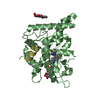
 要素
要素 Homo sapiens (ヒト) / 遺伝子: GRL, NR3C1, PGR / プラスミド: pHis GST / 発現宿主:
Homo sapiens (ヒト) / 遺伝子: GRL, NR3C1, PGR / プラスミド: pHis GST / 発現宿主: 
 X線回折 / 使用した結晶の数: 1
X線回折 / 使用した結晶の数: 1  試料調製
試料調製 シンクロトロン / サイト:
シンクロトロン / サイト:  APS
APS  / ビームライン: 17-ID / 波長: 1 Å
/ ビームライン: 17-ID / 波長: 1 Å 分子置換
分子置換 解析
解析 分子置換 / 解像度: 2.1→19.85 Å / Cor.coef. Fo:Fc: 0.957 / Cor.coef. Fo:Fc free: 0.933 / WRfactor Rfree: 0.261 / WRfactor Rwork: 0.216 / Occupancy max: 1 / Occupancy min: 0.5 / FOM work R set: 0.696 / SU B: 16.499 / SU ML: 0.221 / SU R Cruickshank DPI: 0.221 / SU Rfree: 0.192 / 交差検証法: THROUGHOUT / σ(F): 0 / ESU R: 0.22 / ESU R Free: 0.191 / 立体化学のターゲット値: MAXIMUM LIKELIHOOD / 詳細: HYDROGENS HAVE BEEN ADDED IN THE RIDING POSITIONS
分子置換 / 解像度: 2.1→19.85 Å / Cor.coef. Fo:Fc: 0.957 / Cor.coef. Fo:Fc free: 0.933 / WRfactor Rfree: 0.261 / WRfactor Rwork: 0.216 / Occupancy max: 1 / Occupancy min: 0.5 / FOM work R set: 0.696 / SU B: 16.499 / SU ML: 0.221 / SU R Cruickshank DPI: 0.221 / SU Rfree: 0.192 / 交差検証法: THROUGHOUT / σ(F): 0 / ESU R: 0.22 / ESU R Free: 0.191 / 立体化学のターゲット値: MAXIMUM LIKELIHOOD / 詳細: HYDROGENS HAVE BEEN ADDED IN THE RIDING POSITIONS ムービー
ムービー コントローラー
コントローラー






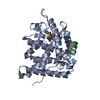


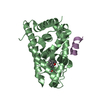
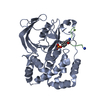
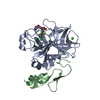
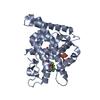

 PDBj
PDBj


